South Cumberland Islands is a national park in Queensland, Australia, 831 km northwest of Brisbane. It is famous for the marine stingers which can be found in the waters of the park between October and May.

Uroplatus is a genus of geckos, commonly referred to as leaf-tail geckos or flat-tailed geckos, which are endemic to Madagascar and its coastal islands, such as Nosy Be. They are nocturnal, insectivorous lizards found exclusively in primary and secondary forest.

Phyllurus is a small genus of Australian leaf-tailed geckos, lizards in the family Carphodactylidae. Rarely seen outside their native habitat, they are notable for their highly effective camouflage which is in part aided by the spiny tubercles that cover every body part.
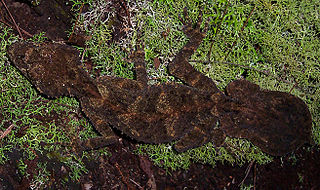
Saltuarius is a genus of larger Australian geckos, known collectively as leaf-tailed geckos. The genus was created in 1993 to accommodate some former members of the genus Phyllurus. These geckos appear very similar to the Uroplatus geckos native to Madagascar. However, this is a convergent evolution.

Saproscincus is a genus of skinks native to Australia, sometimes referred to as shadeskinks. It contains the following species:

Cape Melville is a headland on the eastern coast of the Cape York Peninsula in Australia. To its west lies Princess Charlotte Bay. It is part of the Cape Melville National Park. Cape Melville was named Stoney Cape in 1815 by Lieutenant Charles Jeffreys on the HM Kangaroo but later renamed by him as Cape Melville
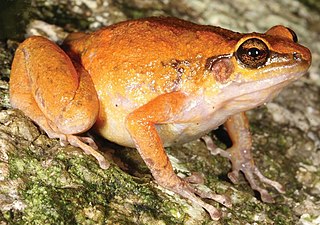
Cophixalus zweifeli is a species of frog in the family Microhylidae. It is endemic to northern Queensland, Australia, and only known from the area of its type locality in the Cape Melville National Park. The species was named to honour American herpetologist Richard G. Zweifel. Common name Zweifel's frog has been coined for it. It is one of the five northeast Australian Cophixalus species that are specialized in boulder field habitats.
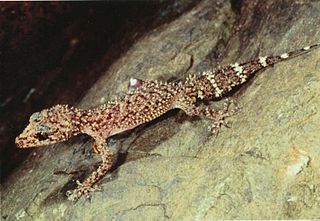
Champion's leaf-tailed gecko, also known commonly as the Koumala leaf-tailed gecko, is a species of gecko, a lizard in the family Carphodactylidae. The species is endemic to Australia.
The Cape Melville shadeskink is a species of lizards from the Cape York Peninsula of Queensland, Australia, described in 2013. It was one of three vertebrates discovered by scientists from James Cook University and National Geographic in an area of mountain rainforest in North Queensland. The lizards are active by day, running and jumping through the mossy boulder fields of Northern Queensland.
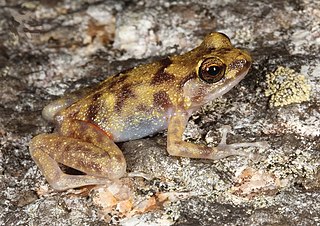
Cophixalus petrophilus, the blotched boulder-frog, is a species of frogs from the Cape York Peninsula that was described in 2013. It is one of three newly described vertebrate species from Cape Melville, Australia, the other two being skink Saproscincus saltus and gecko Saltuarius eximius. The specific name petrophilus means "rock-loving" and refers to restriction of this species to boulder field habitats.

The northern leaf-tailed gecko is a species of the genus Saltuarius, the Australian leaf-tailed geckos.
Orraya is a monotypic genus of lizard in the family Carphodactylidae. The genus contains the sole species Orraya occultus, also known commonly as the McIlwraith leaf-tailed gecko or the long-necked northern leaf-tailed gecko. The species is endemic to Australia.
Phyllurus amnicola, also known as the Mount Elliot leaf-tailed gecko or the Riverine leaf-tailed gecko, is a species of gecko found in Australia. It is endemic to Mount Elliot in Bowling Green Bay National Park in northeastern Queensland.
Saltuarius kateae, also known commonly as Kate's leaf-tailed gecko or the Mount Marsh leaf-tailed gecko is a species of gecko, a lizard in the family Carphodactylidae. The species is native to New South Wales.
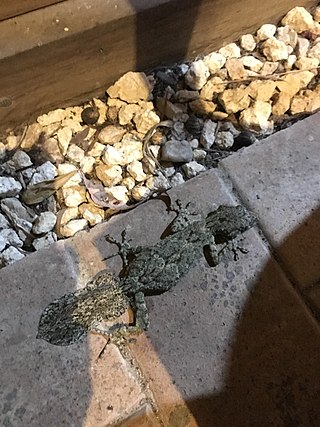
Saltuarius moritzi, also known commonly as the New England leaf-tailed gecko or Moritz's leaf-tailed gecko, is a species of lizard in the family Carphodactylidae. The species is native to Australia.

Saltuarius salebrosus, also known as the rough-throated leaf-tailed gecko or Central Queensland leaf-tailed gecko, is a gecko found in Australia. It is endemic to dry areas in mid-eastern and south-central Queensland.

Amalosia jacovae, also known commonly as the clouded gecko or the clouded velvet gecko, is a species of lizard in the family Diplodactylidae. The species is endemic to Australia.
Cyrtodactylus hoskini is a species of gecko, a lizard in the family Gekkonidae. The species is endemic to Australia.

Pygopodoidea is a gecko superfamily and the only taxon in the gekkotan subclade Pygopodomorpha. The clade includes three Australasian families: Diplodactylidae, Carphodactylidae, and Pygopodidae. Traditional gekkotan systematics had considered Diplodactylidae and Carphodactylidae as subfamilies of the family Gekkonidae, but recent molecular work have placed Pygopodidae within Gekkonidae making it paraphyletic. These analyses have shown support of Pygopodidae and Carphodactylidae being sister taxa, with Diplodactylidae occupying a basal position in Pygopodoidea.

Phyllurus fimbriatus, the Scawfell Island leaf-tailed gecko, is a large species of gecko endemic to mid-east Queensland, Australia.













